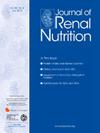Serum Phosphate Levels and Mortality in Incident Hemodialysis Patients: A National Retrospective Cohort Study
IF 3.2
3区 医学
Q2 NUTRITION & DIETETICS
引用次数: 0
Abstract
Objectives
Mineral and bone disorders are frequent in patients in hemodialysis (HD) but a definite association of serum phosphate levels with mortality in this population is still an unmet issue. We assessed the association of three phosphate-level ranges with mortality in incident HD patients.
Methods
This national registry-based retrospective cohort study included 6214 incident adult patients on HD for >3 months. Data were collected from January 2011 to December 2018. The serum phosphate levels, represented by the median levels over the course of the entire HD treatment, were stratified into 3 ranges: <3.5 mg/dL, 3.5-5.5 mg/dL, and >5.5 mg/dL. The main outcome was 4-year all-cause mortality.
Results
The frequencies of cases in the lower, intermediate, and higher phosphate ranges were 5.8%, 64.6%, and 29.6%, respectively. In the fully adjusted multivariate model, the higher adopted phosphate range but not the lower one showed a significant association with mortality (hazard ratio [HR]: 1.54, 95% confidence interval [95% CI]: 1.21-1.95, P< .001). In the model, sevelamer, alone (HR: 0.44, 95% CI: 0.32-0.60, P< .001) or in combination with calcium-based phosphate binders (HR: 0.63, 95% CI: 0.40-0.98, P= .041), proved protective. In subgroup analyses, the lower adopted phosphate range was significantly associated with mortality only in patients <60 years. In a sensitivity analysis, we evaluated the effect of incremental intervals of 0.5 mg/dL across the phosphate distribution (from <2.0 mg/dL to ≥8.0 mg/dL), when serum phosphate <2.0 mg/dL was strongly associated with mortality (HR: 21.9, 95% CI: 2.99-160.66, P= .002).
Conclusion
The study reinforced the association of high phosphate levels with mortality in incident HD patients. The use of sevelamer was associated with a lower mortality rate when compared to the use of calcium-based phosphate binders. The lower adopted phosphate range was only associated with mortality in patients <60 years. In a sensitivity analysis though, phosphate levels below 2.0mg/dl were strongly associated with mortality.
血清磷酸盐水平与血液透析患者的死亡率:一项全国性回顾性队列研究。
目的:矿物质和骨骼疾病在血液透析(HD)患者中很常见,但在这一人群中,血清磷酸盐水平与死亡率的明确关联仍然是一个未解决的问题。我们评估了三种磷酸盐水平范围与HD患者死亡率的关系。方法:这项以全国登记为基础的回顾性队列研究纳入了6214例成年HD患者,患者持续bb103个月。数据收集时间为2011年1月至2018年12月。在整个HD治疗过程中,以中位数水平表示的血清磷酸盐水平分为3个范围:5.5 mg/dL。主要结局为4年全因死亡率。结果:低磷酸盐、中磷酸盐、高磷酸盐发生率分别为5.8%、64.6%、29.6%。在完全调整的多变量模型中,较高的采磷范围与死亡率有显著相关性,而较低的采磷范围与死亡率无显著相关性(风险比[HR]: 1.54, 95%可信区间[95% CI]: 1.21-1.95, P< .001)。在模型中,sevelamer单独使用(HR: 0.44, 95% CI: 0.32-0.60, P< 0.001)或与钙基磷酸盐结合剂联合使用(HR: 0.63, 95% CI: 0.40-0.98, P= 0.041)证明具有保护作用。在亚组分析中,仅在患者中采用较低的磷酸盐水平与死亡率显著相关。结论:该研究强化了高磷酸盐水平与HD患者死亡率的关联。与使用钙基磷酸盐粘合剂相比,sevelamer的使用与较低的死亡率相关。采用较低的磷酸盐范围仅与患者的死亡率有关
本文章由计算机程序翻译,如有差异,请以英文原文为准。
求助全文
约1分钟内获得全文
求助全文
来源期刊

Journal of Renal Nutrition
医学-泌尿学与肾脏学
CiteScore
5.70
自引率
12.50%
发文量
146
审稿时长
6.7 weeks
期刊介绍:
The Journal of Renal Nutrition is devoted exclusively to renal nutrition science and renal dietetics. Its content is appropriate for nutritionists, physicians and researchers working in nephrology. Each issue contains a state-of-the-art review, original research, articles on the clinical management and education of patients, a current literature review, and nutritional analysis of food products that have clinical relevance.
 求助内容:
求助内容: 应助结果提醒方式:
应助结果提醒方式:


